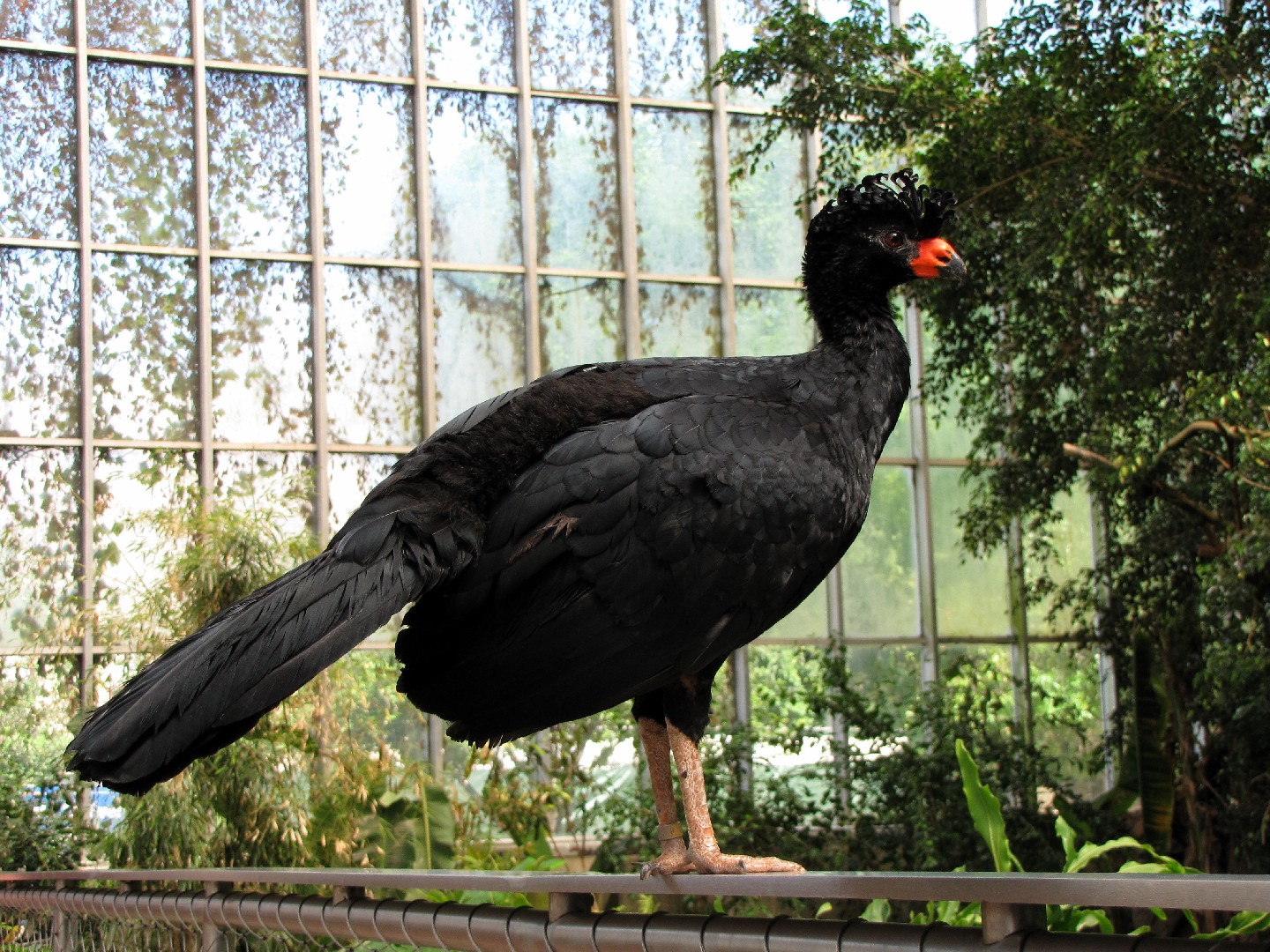Wattled Curassow
A species of Curassows Scientific name : Crax globulosa Genus : Curassows
Wattled Curassow, A species of Curassows
Botanical name: Crax globulosa
Genus: Curassows
Content
Description General Info
Description
The wattled curassow is about 82–89 cm (32–35 in) long, and weighs around 2,500 g (88 oz). It is a large curassow lacking the white tail-tips found in many of these birds; the feathers along the crest of its head are curled forwards. Males have black plumage all over except for the white crissum. The irides are dark brown; legs, feet and bill are blackish. It has conspicuous crimson bill ornaments—a round red knob with bony core adorns the maxilla base, while the cere extends apically at least halfway under this knob and below the mandible base forms a small fleshy wattle. Females have black plumage just like the male, but their crissal area is reddish buff. In some, the remiges and sometimes the wing coverts have faint brownish marbling. Their bills and irides are also blackish, but their feet and legs are a greyish flesh color. They lack the bill knob and wattles, and their cere is bright orange-red. Young males have less well-developed facial ornaments, usually with a more yellowish hue like females do. The hatchlings are covered in brown down above and whitish down below. 
Size
89 cm
Life Expectancy
20 years
Nest Placement
Tree
Feeding Habits
Wattled Curassow has a diverse diet including fruits, seeds, and cultivated fruits. It also preys on vertebrates and invertebrates, exhibiting varied foraging behaviors. Its dietary adaptations enable it to exploit a wide range of food sources.
Habitat
Wattled Curassow thrives in humid tropical lowland forests close to water sources, predominantly within the elevation of up to 300 m. These birds inhabit river island forests, stream environs, blackwater river territories, and lakeside areas. They display adaptability to various wetland ecosystems, favoring younger, vine-rich forests over mature floodplain habitats and exhibit a more arboreal lifestyle than their counterparts.
Dite type
Frugivorous
General Info
Feeding Habits
Bird food type

Fruit
Distribution Area
It has been found from the western and southwestern Amazon Basin of Brazil west to the Andes foothills of southeastern Colombia, eastern Ecuador and Peru, and northern Bolivia. Its area of occurrence is essentially delimited by the Caquetá-Japurá, Solimões, Amazon and Madeira Rivers, and the 300 meter contour line towards the Andes. But its precise distribution is very little-known; most populations were observed by people travelling along the rivers in its range. Most of the northern limit of its range runs along the middle Amazon River, or Solimões. In northern Peru where the Marañón River becomes the Amazon river (Solimões for Brazilians), close to Nauta, the range continues upstream towards eastern Amazonian Ecuador along the Caquetá-Japurá; it has been recorded from the Yavarí and middle Napo Rivers. It is probably not found anymore in Ecuador proper, and apart from two small populations—Isla Mocagua in the Amazon River and near the Caquetá—it is also absent from Colombia. To the eastern limit of its range, the Madeira River, upstream in Bolivia, the wattled curassow occurs patchily across most of northern Bolivia in a 700 km region surrounding the confluences to the Madeira's tributaries, four major rivers of northern Bolivia. In Brazil, the bird is only found in the wild in Amazonas state (it used to occur in Rondônia also), namely near the Juruá, the Javary, the Japurá, and at its northeasternmost limit around the confluence regions along the Solimões, Madeira, Rio Negro, and the Purus Rivers. 
Species Status
The wattled curassow is rarely found in the wild anymore, due to unsustainable hunting and habitat destruction. While its status has rarely been well studied, the number of old and modern records strongly indicates that it is much rarer nowadays than it was in the late 19th century. The species seems to have disappeared from Ecuador in the 1980s, while populations persist in remote areas of the other countries from which it is known. It is nowhere numerous, and the only known region where it can be encountered reasonably often might be along the Juruá River in Brazil, in particular in the Mamirauá Sustainable Development Reserve; it is also present in some numbers near San Marcos in Beni Department, Bolivia. It might occur in unexplored locations; its presence in Colombia for example was only proven around 1950 when a bird was shot in Caquetá Department, at Tres Troncos on the Caquetá River (from where the species has since disappeared). But any undiscovered populations are unlikely to be large—and even though they might remain unknown to science as soon as hunting with firearms starts in a region the wattled curassow is liable to get shot more often than it reproduces. There may be somewhat more than 10,000 adult C. globulosa left in the world, but if few other populations exist apart from those known, it might number less than 5,000 individuals old and young altogether. A captive stock exists and by curassow standards is even reasonably plentiful. The species occasionally breeds in captivity, but this is entirely insufficient to counteract the decline in the wild—in particular as it is receives little legal protection and is not known from any protected area other than the Mamirauá Sustainable Development Reserve (a population from the Apaporis River near Chiribiquete National Park is apparently gone). The IUCN used to classify the wattled curassow as a Vulnerable species under criteria A2bcd+3bcd+4bcd; C2a(i). This means that its numbers have declined and continue to decline by about one-third every decade, mainly due to hunting, with habitat destruction as another major threat, and that most likely between 2,500 and 10,000 adults exist, but not more than 1,000 in any one subpopulation. In 2010, this classification was uplifted to Endangered. 
